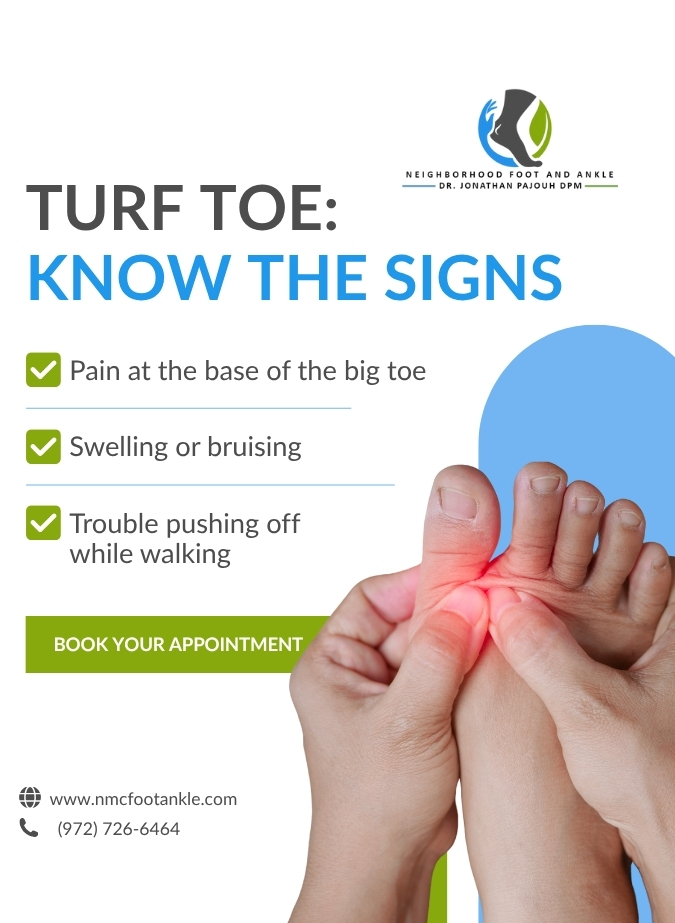
Know the Signs and How to Address Them Effectively
Did you know that even athletes can find themselves sidelined by what seems like a minor injury? Turf toe, a sprain of the big toe joint, can affect anyone from professional football players to weekend warriors. Understanding the early signs, causes, and treatment options for turf toe is crucial for anyone who engages in sports or high-activity lifestyles. In this blog post, we’ll dive deep into the key signs of turf toe, effective prevention strategies, and treatment methods that can help you recover faster and return to your favorite activities. Whether you’re currently experiencing symptoms or just looking to educate yourself to avoid injury, this guide is for you.
What is Turf Toe?
Turf toe is a common term for a sprain of the ligaments around the big toe joint (first metatarsophalangeal joint). It usually occurs as a result of hyperextension, where the big toe is bent upwards beyond its normal range, often during activities that involve running or jumping. Though it sounds trivial, turf toe can lead to significant pain and can affect performance if not properly addressed.
Common Symptoms of Turf Toe
Understanding what to look out for is essential. Here are the most prevalent symptoms associated with turf toe:
- Pain at the base of the big toe: This is often the first and most noticeable symptom. Athletes may start to feel discomfort while pushing off their foot during running or jumping.
- Swelling or bruising: The affected area can become swollen and may show bruising, indicating inflammation and injury.
- Difficulty pushing off: Those with turf toe might experience challenges when trying to run or walk, especially when transitioning from a stationary position.
Ignoring these signs can result in worsening conditions that prolong recovery time and complicate treatment.
Causes of Turf Toe
Most often, turf toe is related to:
- Sports activities: Many athletes, especially those involved in sports played on turf (like football, soccer, or basketball), are at higher risk.
- Improper footwear: Wearing shoes that do not provide adequate support or fit properly can contribute to the likelihood of a turf toe injury.
- High-impact activities: Any activities that put strain on the big toe joint can be a cause, especially if the movement is sudden or awkward.
Risk Factors
While anyone can experience turf toe, certain risk factors make some individuals more susceptible:
- Age: Younger athletes may be more at risk because of the increased likelihood of playing sports or activities that cause turf toe.
- Playing on artificial turf: Athletes playing on synthetic surfaces are more susceptible due to the grip these surfaces provide, which can increase the risk of hyperextension.
- Previous injuries: Individuals with a history of foot or toe injuries may be at greater risk of experiencing turf toe again.
Diagnosis of Turf Toe
If you believe you are experiencing symptoms of turf toe, it is essential to consult a health care professional. A doctor will typically conduct a physical examination and may use imaging tests, such as an X-ray or MRI, to assess the injury severity. Understanding the extent of the injury is pivotal for determining the appropriate treatment path.
Treatment Options
Treatment for turf toe usually involves conservative care initially:
- Rest: Avoid any activity that puts pressure on the toe. Depending on the severity, complete rest may be recommended.
- Ice: Applying ice packs can reduce swelling and alleviate pain. Aim for 20 minutes every couple of hours, particularly during the first 48 hours post-injury.
- Compression: Using bandages can help limit swelling and provide support.
- Elevation: Keeping the foot elevated can assist in controlling swelling.
In some cases where pain persists or surgery is needed, a doctor may recommend additional options:
- Physical therapy: Once initial pain has subsided, physical therapy can assist in rehabilitation, focusing on strength and flexibility.
- Orthotics or protective toe devices: Custom orthotics or splints can provide additional support while promoting healing.
- Surgery: Rarely, severe cases may require surgical intervention for ligament repair.
Prevention Strategies
Taking measures to prevent turf toe is always the best strategy. Here are some tips:
- Choose the right footwear: Selecting shoes that provide adequate support and cushioning can mitigate the risk of injury. Look for footwear designed for your particular sport.
- Warm-up properly: Engaging in a thorough warm-up before any activity can help prepare your body and lessen the chances of injury.
- Strength training: Focus on strength exercises that enhance the stability of your feet and toes. Incorporating flexibility training can also be beneficial.
- Be cautious: Pay attention to how your body feels during activities. If you feel discomfort in your big toe, it’s essential to address it early to avoid further injury.
Taking Control of Your Foot Health
Turf toe is a common yet often overlooked injury that can significantly impact your athletic performance and daily activities. Understanding the signs, prevention, and treatment options can empower both athletes and non-athletes alike to take control of their foot health. By being proactive, you can avoid situations that may sideline you due to injury.
Book Your Appointment
If you suspect that you're dealing with turf toe, don't wait—address the injury early on to avoid further complications. Schedule an appointment with Dr. Pajouh to discuss your symptoms and explore your options. https://www.zocdoc.com/doctor/jonathan-pajouh-dpm-320983
